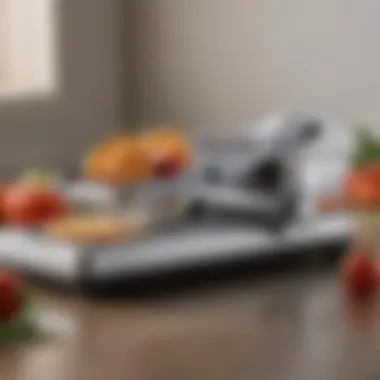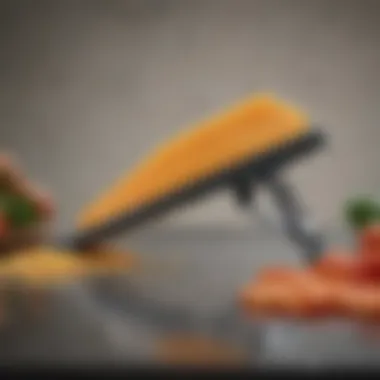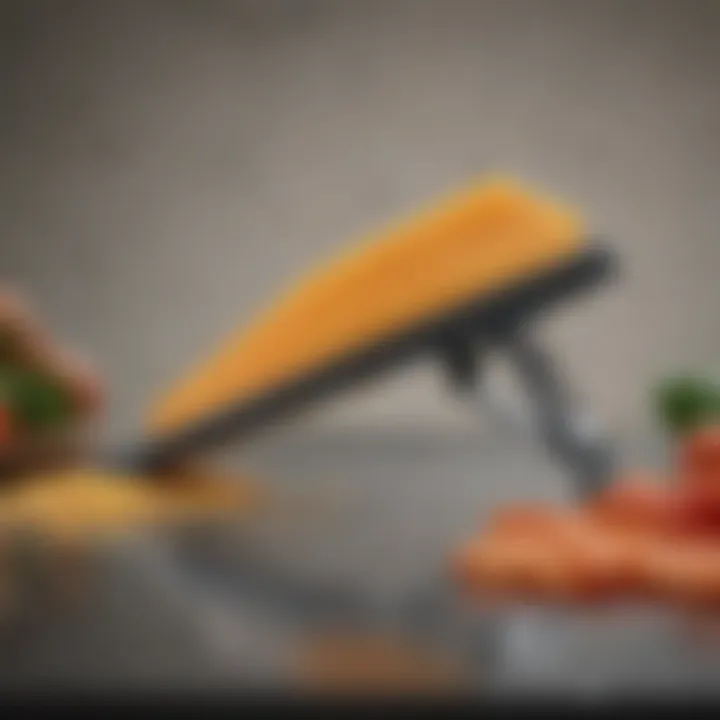Explore Top Commercial Mandoline Slicers for Kitchens


Intro
When it comes to preparing meals, speed and precision can make all the difference. One tool that professionals and home cooks alike often turn to is the mandoline slicer. This nifty device allows for uniform slicing of fruits and vegetables, which not only enhances the presentation of a dish but also improves cooking efficiency. Whether you're looking to whip up a salad with perfectly sliced cucumbers or preparing a gratin with thinly cut potatoes, understanding the best commercial mandoline slicers on the market can elevate your culinary game.
But what exactly should you look for in a mandoline slicer? With options ranging from budget models to professional-grade equipment, navigating the landscape can be daunting. This article takes a closer look at key features, maintenance tips, and user considerations to ensure you're equipped with the right knowledge before making a purchase. You’ll gain insights into safety features, innovative designs, and practical applications, making it easier to decide what meets your culinary needs.
So, buckle up as we slice through the nitty-gritty of mandoline slicers, ensuring you get the most bang for your buck while also adding a dash of flair to your kitchen prowess.
Understanding Mandoline Slicers
Understanding mandoline slicers goes beyond simple definitions; it focuses on recognizing their role in enhancing culinary practices. These tools, while appearing straightforward at first glance, possess multifaceted functionalities that can significantly change how food is prepared in both commercial kitchens and home setups.
Definition and Functionality
A mandoline slicer is primarily a kitchen device designed for slicing vegetables and fruits with precision. Its sharp, adjustable blades allow users to create uniform cuts of varying thicknesses, which can be instrumental in achieving desirable textures and presentations in dishes. The tool utilizes a manual approach, relying on the user’s motions to slice rather than relying on electric mechanisms. This aspect not only engages the cook but also allows for greater control over each slice.
Here’s what makes mandolines especially valuable:
- Versatility: From paper-thin slices of zucchini for a salad to thick cuts for hearty vegetable chips, a mandoline can handle various tasks with ease.
- Speed: Compared to traditional knife work, a mandoline can exponentially speed up the process. You can prepare large amounts of produce in a fraction of the time.
- Consistency: Achieving uniform slices is a challenge with a knife, but a mandoline ensures every cut is not just uniform but often perfect; this can be crucial for professional presentation.
"In the culinary world, presentation is key, and what better way to ensure stunning visuals than with evenly sliced ingredients?"
Historical Context
Tracing back the history of mandoline slicers provides insights into how kitchen tools evolve alongside changes in cooking practices. The origins of the mandoline date back to France in the late 18th century, where it was crafted to facilitate food prep in bustling kitchens. As French cuisine emphasized the art of presentation, the need for tools that could create uniform slices became apparent.
Over the years, mandolines have undergone several transformations as manufacturers began to explore different materials and designs. Early models were primarily made from wood, whereas contemporary ones are often crafted from stainless steel and high-quality plastics, making them more durable and easier to clean.
The innovation didn’t stop with materials; today’s mandolines often include various attachments and features not present in their predecessors. They are not just strips of metal—some have changeable blades that can create julienne cuts, grating options, and even slicing for waves, enriching culinary possibilities.
In summary, understanding the fundamentals of mandoline slicers lays a strong foundation for making informed decisions about which slicer to incorporate into your kitchen. With an appreciation of their design, functionality, and historical significance, one might navigate the modern landscape of culinary tools with greater insight.
Importance in Culinary Practices
When we think about culinary endeavors, efficiency and precision often rise to the top of the priority list. The significance of mandoline slicers in both professional and home kitchens cannot be understated, as these tools transform the way ingredients are prepared. This section delves into the essential elements that underline the importance of using mandoline slicers, specifically focusing on efficiency in food preparation and the uniformity in slicing.
Efficiency in Food Preparation
One of the most compelling aspects of mandoline slicers is their ability to streamline food preparation. In a busy kitchen where time is of the essence, these tools allow cooks to slice, julienne, and shred fruits and vegetables quicker than traditional methods would permit. Not only does this speed up the cooking process, but it also minimizes the labor involved, freeing up chefs to focus on other tasks or to create new dishes.
Using a good mandoline slicer can cut down the preparation time significantly. For instance, when it comes to slicing potatoes for a gratin, a mandoline can turn a mountain of spuds into perfectly even slices in a matter of minutes.
"The mandoline slicer is a chef’s secret weapon—like a trusty sword in the kitchen!"
The versatility of these devices can be particularly beneficial during meal prep for large gatherings or events. For instance, catering services utilize mandolines to create stunning vegetable platters in no time, boasting both speed and efficiency. When the order of the day is a big event, making sure everything is prepped in advance means you can face the crowd with confidence.
Uniformity in Slicing
Another major advantage of mandoline slicers is their ability to deliver uniform slices, which has a profound impact on both the aesthetic aspects of dishes and their cooking properties. Consistent shapes and thicknesses ensure that everything cooks at the same rate, which is especially important for dishes that require precision, like stir-fries or salads.
When you slice potatoes or zucchini evenly, you’re not just creating a visually appealing dish; you’re ensuring that each piece will cook uniformly, preventing some pieces from turning mushy while others remain crunchy.
A well-sliced vegetable will not only make your meal more enticing, but also provide a better texture overall. Think of a ratatouille, where each vegetable contributes not just to the flavor but to the overall presentation; uneven cuts could compromise the dish.
In sum, mandoline slicers serve essential roles in making food preparation efficient and ensuring perfect uniformity in slicing. As cooks navigate their kitchen tasks, the benefits of incorporating mandoline slicers become abundantly clear. The balance they create between speed and accuracy can transform a typical cooking process into an art, inviting an enhanced culinary experience for both the chef and the diners.
Criteria for Selecting a Commercial Mandoline Slicer
When it comes to choosing a mandoline slicer that you can rely on, there are pivotal criteria that must be considered. Selecting the right slicer isn’t merely about picking the first thing you see on the shelf; it’s about ensuring that your culinary experience is efficient, safe, and, importantly, enjoyable. A poorly chosen slicer can lead to uneven cuts, frustration during food prep, and even accidents in the kitchen. So, let’s delve into some critical elements that will guide you through this decision-making maze.
Blade Quality and Material
The blade of a mandoline slicer is undeniably its heart and soul. A top-notch blade is essential for achieving clean, precise cuts. Generally, you’ll find blades made of stainless steel, which is often favored for its durability and resistance to rust. However, not all stainless steel is created equal. Higher-grade stainless steel will hold its sharpness longer, which translates into less frequent sharpening, something any cook can appreciate.


Additionally, consider the thickness of the blade. A thicker blade can tackle tougher ingredients like squash or sweet potatoes, while a thinner blade works well for softer vegetables and fruits.
A wise user might also look for slicers that boast interchangeable blades, allowing for greater versatility in slicing options. This feature can be a game-changer when you're in a pinch and need to switch from chips to julienne cuts without a hassle.
Adjustable Thickness Settings
Imagine wanting to make the perfect gratin or some delicate vegetable chips. The thickness of the cut can significantly affect the final dish. Adjustable thickness settings provide the flexibility to achieve desired results, ranging from paper-thin slices to thick cuts that can withstand heat during cooking.
To give you a clearer picture, consider the following:
- Precision: Making a salad? You might want thin, uniformly sliced cucumbers.
- Variety: Cooking a stir-fry? You might need thicker pieces for a satisfying crunch.
Many modern mandolines offer a dial or lever system to adjust thickness without needing numerous attachments. This not only saves time but also reduces the risk of cross-contamination if switching between foods frequently. Being able to dial in your cut can mean the difference between a successful dish and a culinary flop.
Ease of Cleaning and Maintenance
Let’s face it, after an intense cooking session, the last thing anyone wants is to tackle a complicated clean-up process. An ideal mandoline slicer should provide an easy-to-clean design. Look for slicers that have dishwasher-safe parts or those that can be easily rinsed and wiped down after use.
Moreover, assess how accessible the blade is when it comes time to clean it. Some slicers have detachable blades, making it easier to wash and maintain hygienic practices. Grime can build up fast, so you’ll want a model that facilitates straightforward maintenance.
A well-maintained mandoline not only prolongs its lifespan but also ensures that you’re consistently producing dishes that look and taste great.
"Selecting a mandoline slicer based on blade quality, adjustability, and ease of cleaning can ensure a satisfying culinary journey."
In summation, the choice of a commercial mandoline slicer is crucial. It’s all about aligning your equipment with your culinary ambitions, ensuring that each ingredient is prepared with precision, style, and ease.
Top Commercial Mandoline Slicers in the Market
Working in a busy kitchen, whether it’s a professional environment or a home setup, requires tools that both maximize efficiency and cost. Commercial mandoline slicers stand out for their ability to deliver fast, precise cuts, which can be the difference between a mediocre dish and a culinary triumph. In this section, we will dig into what makes these slicers worth considering, looking at how their unique features can greatly enhance your food prep rituals.
Overview of Popular Brands
When it comes to mandoline slicers, a handful of brands have made a name for themselves in the culinary world. These brands often embody quality and reliability, hallmarks that every chef or home cook should aim for when selecting a slicing device.
- Benriner: Renowned for their lightweight yet durable designs, Benriner slicers are a favorite among professional chefs. They offer various blades for different cuts, making them versatile for any kitchen task.
- Swissmar: This company is known for its precision and safety features. Swissmar slicers often come with built-in guards that enhance safety while slicing, a crucial factor for those who might be handling the tool daily.
- OXO: Known for their user-friendly designs, OXO slicers feature ergonomic handles and straightforward adjustments, appealing to both novices and seasoned chefs alike.
- V_authentic: This brand specializes in creating high-end products, designed with durability in mind. They tend to offer a broader range of blade types, catering to diverse culinary needs.
Each brand has its own set of features that appeal to different user preferences, making it important to consider what fits best for your culinary pursuits.
Product Comparisons
With so many options gravitating towards the commercial realm, it can be a challenge to navigate which slicer stands out and why. Here, we shall compare some of the notable models, highlighting their strengths and weaknesses.
| Brand | Model | Key Features | Price Range | | Benriner | Benriner #4 | Adjustable settings, various blade options | $35 - $50 | | Swissmar | Swissmar V-Slicer| Safety guard, easy to clean, several cutting styles | $50 - $75 | | OXO | OXO Good Grips | Ergonomic design, non-slip base, safety features | $30 - $50 | | V_authentic | V_authentic Mandoline | Commercial-grade, multiple attachments | $60 - $100 |
"Investing in a good mandoline slicer can cut down prep time and enhance your kitchen efficiency tremendously."
In this table, we can see that while price varies, the functionality and safety of each tool also differ. A higher price tag does not always guarantee better performance. Factors such as ease of use, versatility, and safety features should greatly guide your decision.
When evaluating these mandoline slicers, ask yourself:
- How often will I use this tool?
- Do I prefer multiple slicing options?
- Am I comfortable with the safety features offered?
Answering such questions will help narrow down which slicer aligns best with your everyday kitchen exploits. The right choice can not only enhance the dish but also ensure a smoother cooking experience.
Crafting Slices: Techniques and Tips
When it comes to using a mandoline slicer, the difference between a novice and a seasoned pro lies not just in the tool selected, but in the technique applied. Crafting perfect slices enhances both the presentation and the texture of the food being prepared. So, it’s worth investing time into mastering some effective techniques. Understanding these will not only elevate a dish's appearance but can genuinely impact the overall cooking experience.
Basic Slicing Techniques
Using a mandoline slicer can be simple, yet it requires a bit of finesse to get it right. Here are some foundational techniques to consider:


- Grip and Safety: Always use the hand guard. This little gizmo may feel like it’s slowing you down at first, but it’s paramount in protecting your fingers.
- Stabilizing Your Mandoline: Make sure that the slicer is stable on the countertop. Any wobble can cause uneven slices. If your slicer has rubber feet, use them well.
- Angle Matters: Tilt the produce slightly when slicing. This technique provides a better grip and helps achieve even cuts, especially with slippery vegetables like cucumbers.
- Consistent Pressure: Maintain a steady pressure as you push the item through the blade. Too much force can lead to mishit slices while too little can slow down the process.
For example, when slicing potatoes, they should be placed flat against the base of the mandoline, using a quick and steady motion to push them through the blade, leading to perfectly uniform potato slices ideal for chips or casseroles.
Advanced Preparations and Cuts
Once you are comfortable with basic slicing, it’s time to venture into more intricate slicing techniques that can truly impress:
- Julienne Technique: This involves slicing food into thin, matchstick-like strips. Begin with a larger piece of produce and slice lengthwise, adjusting the mandoline blade for smaller cuts. This technique shines in salads or garnishes.
- Ribbed Cuts for Presentation: Some mandolines come with a feature that creates a ribbed effect. This adds not only texture but also aesthetics to dishes. Ideal for vegetables served raw or for layered presentations.
- Diagonal Slicing: Instead of standard straight cuts, tilt the food at an angle to create visually striking diagonal slices. This method works wonders for eggplants or squash, making your dish look like it came straight from a restaurant.
- Varied Thickness for Depth: By adjusting your mandoline’s thickness settings, you can create slices that’re thick for roasting or thin for salads. For instance, thick slices of zucchini work well in a ratatouille, while thin slices are preferable for a refreshing salad.
Achieving these advanced cuts takes practice and patience. But, the outcome is worth every moment spent in honing your skills.
"Great chefs are not made in school. They are made from something they have deep inside them – a desire, a dream, a vision." – Mario Batali
Safety Measures and Best Practices
When it comes to using mandoline slicers, safety should be at the forefront of every user’s mind. These kitchen tools, while incredibly useful for creating uniform slices quickly, can also be hazardous if not handled with care. Emphasizing safety measures helps prevent accidents in the kitchen, making the slicing experience efficient and enjoyable. Understanding and implementing the right safety practices is essential not only for novices but also for seasoned chefs who may become complacent over time.
Using Safety Guards
One of the most crucial elements in ensuring safety while using a mandoline slicer is the utilization of safety guards. These devices are designed to protect fingers from the sharp blades, which can slice through food with ease but pose a significant risk to hands. Most commercial mandoline slicers come equipped with safety guards, yet some users may neglect to utilize them, thinking they can slice more effectively without one. This is a risky assumption.
Engaging safety guards not only minimizes the threat of cuts, but also provides a more stable surface for the food being sliced. Here's why they are indispensable:
- Physical Barrier: Safety guards act as a physical barrier between your fingers and the blades, offering protection against accidental contact.
- Enhanced Control: They also help in holding the food securely, providing better control during slicing, especially for smaller items like radishes or cherry tomatoes.
- Optimal Thickness: Using safety guards also allows users to maintain the ideal thickness of slices without having to adjust their grip excessively.
In practice, it’s crucial to ensure that the safety guard fits correctly on the mandoline before starting any slicing. By integrating this simple yet effective tool into your routine, you can focus on the slicing rather than worry about potential injuries.
Handling and Storage Guidelines
Just as important as using safety equipment is how you handle and store your mandoline slicer. The way these tools are treated can directly influence their lifespan and your safety when using them. Here are some best practices to consider:
- Use the Right Materials: Ensure that your mandoline slicer is made from durable materials. Metal blades, while sharper, should be properly managed to prevent rust. Opt for slicers that have non-slip feet to provide stability on your workstation while cutting.
- Clean Immediately: After use, clean your mandoline slicer right away. Food particles left stuck to the blades can not only harbor bacteria, but they can also dull the blades over time. Gentle washing with warm soapy water can usually suffice. For tougher residues, a soft scrubber can help without damaging the blade's edge.
- Store Safely: When storing your mandoline slicer, always make sure to store it in a designated place, preferably with the blade covered. Some models come with protective sheaths that should be used. Transparent storage containers can keep it safe while allowing for visibility.
- Keep Out of Reach: Lastly, it’s advisable to keep the slicer out of reach of children, as its sharp blades can pose a severe risk. If you have children in the house, designate a place that only adults can access.
Remember, a good kitchen habit not only protects you today but prolongs the life of your tools for tomorrow.
In summary, prioritizing safety measures and best practices when it comes to using a mandoline slicer can make all the difference in your culinary experience. By being aware of the importance of safety guards and adhering to handling and storage guidelines, you will enhance your kitchen's safety, ensuring that slicing remains an enjoyable and productive task.
User Experiences and Reviews
Understanding how different users interact with mandoline slicers provides valuable insights into their practical applications and efficacy. User experiences and reviews not only highlight the functionality of these tools but also inform potential buyers about the benefits and drawbacks they might encounter. The perspectives gathered from culinary professionals and home cooks form a comprehensive picture of how these slicers perform in various kitchen settings.
Feedback from Culinary Professionals
Culinary professionals often have rigorous standards when it comes to kitchen equipment. Their feedback is particularly insightful because they rely on their tools daily and demand efficiency and precision. Many professional chefs praise commercial mandoline slicers for their ability to elevate their culinary creations. Here are a few thoughtful observations:
- Consistency: Chefs often remark on the crisp, even slices that result from using high-quality mandolines compared to cutting by hand. This uniformity not only enhances presentation but also allows for more accurate cooking times.
- Speed: Many users in this arena highlight how mandolines drastically decrease prep time. For example, slicing a mound of vegetables for a stir-fry can go from laborious to lightning-fast, freeing up time for the more creative aspects of cooking.
- Versatility: Culinary experts appreciate the range of cuts that a good mandoline can deliver, from paper-thin slices to julienne cuts. This versatility encourages experimentation with various dishes, pushing the boundaries of their culinary skills.
- Durability: Professionals often point out the significance of blade materials and construction. Several chefs endorse models that stand the test of time and heavy usage, affirming the importance of investing in a robust slicer.
Overall, culinary professionals often regard mandoline slicers as essential tools that contribute positively to both their efficiency and creativity in the kitchen.
Home Cook Testimonials
Home cooks generally utilize mandoline slicers with different goals and experience levels, thus offering a unique range of perspectives. They often share experiences on various food blogs and forums, allowing potential buyers a glimpse into everyday use. Some key observations from home cooks include:
- Ease of Use: Many users appreciate the straightforward nature of most commercial mandoline slicers. Users with varying levels of kitchen skills testify how quickly they learned to use the tool without a steep learning curve.
- Safety Concerns: While some cooks rave about the speed and efficiency, they also express valid concerns about safety. Many reviews discuss the importance of using the provided safety guard, and some users warn about the potential for accidents if one is not careful.
- Cleaning and Maintenance: Feedback often centers around the ease of cleaning. Various home cooks recommend models that are dishwasher safe or have parts that can be easily taken apart, minimizing the fuss after meal prep.
- Value for Money: Testimonials frequently discuss the balance between price and performance. Some users suggest that investing in a higher-end model pays off in terms of longevity and performance, while others find that more economical options satisfy their needs.
“I was hesitant at first, but after trying it, I couldn’t imagine cooking without my mandoline anymore!”
In essence, both culinary professionals and home cooks enrich the narrative around mandoline slicers. Their reviews paint a fuller picture, guiding prospective buyers toward making informed decisions based on real-life experiences.


Innovations in Mandoline Design
The evolution of mandoline slicers has seen significant advancements that transform standard kitchen tools into highly efficient culinary machinery. Innovations not only focus on aesthetics but also on functionality, convenience, and overall user experience. As culinary enthusiasts and professionals strive for precision, the features and technologies integrated into modern mandolines can make a world of difference. By embracing these innovations, cooks elevate their preparation times, enhance food presentation, and ultimately enrich the dining experience.
Materials and Durability Improvements
Recent years have ushered in a variety of new materials that enhance the durability and longevity of mandoline slicers. Traditionally, these tools relied on stainless steel blades and plastic bodies. However, innovations now include higher-quality metal alloys and reinforced plastics that resist wear and tear much better than ever before.
- High Carbon Steel Blades: Many contemporary models come equipped with high carbon steel blades that maintain sharpness for longer, offering superior slicing performance. Their resistance to corrosion means that even after multiple washes, the integrity remains intact.
- Ceramic Coatings: Some manufacturers have started using ceramic coatings that provide a non-stick surface, reducing the chance of foods sticking to the blades during slicing. This not only simplifies the process but also makes it easier to clean.
- Reinforced Body Structure: Innovations in the design of the mandoline’s body have also led to greater sturdiness. A reinforced frame can handle more pressure without bending or warping, critically important for serious cooking tasks.
Benefits of Material Innovations
- Longevity: This translates to a longer lifespan for the slicer, making it a worthwhile investment for both professional kitchens and home cooks.
- Safety: Enhanced material quality often entails improved ergonomic designs, ensuring that users maintain a safe grip while slicing, reducing the risk of accidents.
- Performance: Less frequent sharpening or downtime due to repairs means that high food prep demands can be met with consistency.
Technological Advancements
The integration of technology into mandoline slicers is revolutionizing the way we slice and prepare ingredients. Innovative features can facilitate unique cuts and improve efficiency, appealing to both novice cooks and seasoned chefs alike.
- Adjustable Settings & Dials: Unlike older models that only offered a couple of thickness options, many new mandolines include precise adjustable dials that allow for minute changes in the thickness of the slices. Whether you need paper-thin celery slices or thick potato wedges, the right setting ensures food presentation is on point.
- Safety Features: There’s a heightened focus on user safety, with features like automatic blade guards and safety grip handles becoming standard. A good number of models now come with self-retracting blades to prevent accidental cuts when cleaning.
- Ergonomic Designs: The ergonomics of mandoline design have improved significantly. Handles and rests are now created to accommodate comfortable gripping, minimizing fatigue during long slicing sessions.
"Innovations in mandoline design have changed the game for prep work. It’s not just about speed anymore; it’s about precision, safety, and enhancing the culinary experience."
By amalgamating these advancements in materials and technology, modern mandoline slicers not only meet the practical demands of peeling, slicing, and julienning but also weaponize the art of presentation. As the culinary landscape continues to shift, so too will the tools employed within it, ensuring every meal can be prepared with the utmost care and skill.
Maintaining and Caring for Your Mandoline Slicer
Maintaining and caring for your mandoline slicer is critical to ensuring its longevity and optimal performance. A well-preserved slicer not only guarantees smooth operation but also enhances safety in the kitchen. Neglecting proper care can lead to diminished efficiency and increased risks of accidents while slicing.
To make the most of your investment, it's fundamental to develop a robust maintenance routine. This includes not just cleaning, but also sharpening the blades and ensuring all parts are functioning as they should. Here’s a closer look at essential processes to follow with your mandoline slicer.
Cleaning Procedures
Regular cleaning is the heart of maintaining your mandoline. Here’s how to do it right:
- Immediate Rinse: After each use, rinse the mandoline parts under warm water. This helps prevent food residues from drying and sticking.
- Use Mild Soap: Apply a soft cloth or sponge with mild dish soap to wipe down the slicer. Avoid abrasive materials as they can scratch the surface and damage the sharp edges of the blades.
- Disassemble Parts: Take the mandoline apart as per the manufacturer’s instructions. This allows for thorough cleaning of all components, especially those tricky nooks and crannies where food debris might hide.
- Dishwasher Safe?: If the slicer parts are dishwasher safe, position them carefully to avoid any shifting or tumbling, which can cause breakage or dullness.
- Dry Properly: After washing, use a lint-free cloth to dry all components. It's crucial to keep the slicer dry to prevent any rust or corrosion.
“A clean slicer is not only safe but also prolongs the life of your investment.”
Sharpening and Replacement Parts
Even the sharpest blades will dull over time, which is why sharpening is a necessary step you can't overlook in caring for your mandoline slicer. It keeps the blades efficient and cuts time down as well. Here's how to handle sharpening and manage replacement parts:
- Sharpening Blades: Depending on usage, consider sharpening the blades every few months. Utilizing a honing stone or a dedicated blade sharpener can do wonders.
- Check for Bumps or Nicks: Regularly inspect the blades for small damages. Keeping them in peak condition prevents uneven or jagged cutting, which can compromise both performance and safety.
- Replacement Blades: When blades become irreparable, sourcing replacement parts from the manufacturer is vital. Compatibility is key here, and not all mandolines may accommodate generic parts.
- Consult the Manual: Each brand comes with its guidelines for maintenance. Don't skip over the manual; it’ll provide insights tailored to your specific model.
Maintaining your mandoline slicer might seem like a chore, but considering the benefits pays off in the long run. With a bit of effort in cleaning and sharpening, you’ll find that your mandoline slicer can remain a reliable kitchen companion, slicing through vegetables and fruits like a hot knife through butter.
End: Choosing the Right Tool for Your Kitchen
When it comes to outfitting your kitchen, selecting the right tools can be a game changer in terms of efficiency and food quality. Among these, a commercial mandoline slicer stands out as a highly versatile instrument. It's not merely about having a sharp blade or adjustable settings; it’s about aligning this tool to your culinary objectives and habits.
In a world where cooking is as much an art as it is a science, having the right equipment can significantly enhance your creative expression in the kitchen. Perhaps you are a home cook seeking to elevate weekly dinners or a chef aiming for professional presentation. Whatever your culinary goals are, the right mandoline slicer can help you achieve precision in slicing, which can improve both the aesthetic and flavor profiles of your dishes.
In your quest for the perfect mandoline, consider
- your cooking frequency,
- the types of dishes you prepare most often, and
- your own proficiency with kitchen equipment.
Aligning with Culinary Goals
The aim of aligning your mandoline slicer with your culinary goals involves a few critical considerations. First off, think about the kinds of fruits and vegetables you often work with. Do you find yourself frequently dicing potatoes for gratins or julienning carrots for salads? Some slicers excel in specific tasks like creating uniform ribbons or thin chips, while others can perform a wide range of cuts. This versatility can save you time in meal prep, letting you focus more on flavoring and less on cutting.
Then there’s safety; different mandolines come with various safety features that can enhance your cooking experience greatly. If you prioritize safety due to past kitchen mishaps, opting for a model with robust safety guards can give you extra peace of mind. Picking the right tool is not just a matter of preference but also about ensuring you enjoy the process of cooking, free from anguish over potential injuries.
Investment versus Value
The dichotomy of investment versus value is often misunderstood when purchasing kitchen gadgets. It’s tempting to grab the cheapest option, thinking it will do the job just fine. But consider the long-term benefits of choosing a quality commercial mandoline slicer.
An initial higher investment can lead to durable performance, making it a cost-effective choice over time. When you invest in a solid product, you are not just buying a slicer; you’re acquiring a dependable partner in your kitchen adventures. Look into the materials, warranty, and user reviews. All these aspects provide clues about the long-term value of your investment.
Ultimately, the goal is to enhance your cooking experience, making processes quicker and more enjoyable without cutting corners on quality. As you weigh options, think of this tool as an investment in your culinary journey—invaluable for both novice and experienced cooks alike.
Choosing the right mandoline slicer is not just about functionality; it’s about elevating your cooking from mundane to magnificent.







